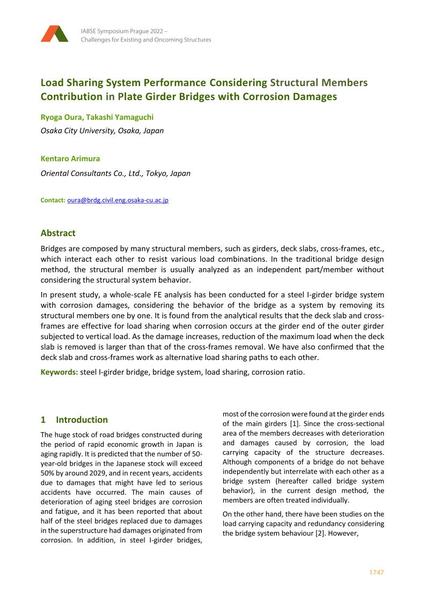Load Sharing System Performance Considering Structural Members Contribution in Plate Girder Bridges with Corrosion Damages

|
|
|||||||||||
Bibliografische Angaben
| Autor(en): |
Ryoga Oura
(Osaka City University, Osaka, Japan)
Takashi Yamaguchi (Osaka City University, Osaka, Japan) Kentaro Arimura (Oriental Consultants Co., Ltd., Tokyo, Japan) |
||||
|---|---|---|---|---|---|
| Medium: | Tagungsbeitrag | ||||
| Sprache(n): | Englisch | ||||
| Tagung: | IABSE Symposium: Challenges for Existing and Oncoming Structures, Prague, Czech Republic, 25-27 May 2022 | ||||
| Veröffentlicht in: | IABSE Symposium Prague 2022 | ||||
|
|||||
| Seite(n): | 1747-1754 | ||||
| Anzahl der Seiten (im PDF): | 8 | ||||
| DOI: | 10.2749/prague.2022.1747 | ||||
| Abstrakt: |
Bridges are composed by many structural members, such as girders, deck slabs, cross-frames, etc., which interact each other to resist various load combinations. In the traditional bridge design method, the structural member is usually analyzed as an independent part/member without considering the structural system behavior. In present study, a whole-scale FE analysis has been conducted for a steel I-girder bridge system with corrosion damages, considering the behavior of the bridge as a system by removing its structural members one by one. It is found from the analytical results that the deck slab and cross- frames are effective for load sharing when corrosion occurs at the girder end of the outer girder subjected to vertical load. As the damage increases, reduction of the maximum load when the deck slab is removed is larger than that of the cross-frames removal. We have also confirmed that the deck slab and cross-frames work as alternative load sharing paths to each other. |
||||
| Stichwörter: |
Brückensystem
|
||||
| Copyright: | © 2022 International Association for Bridge and Structural Engineering (IABSE) | ||||
| Lizenz: | Die Urheberrechte (Copyright) für dieses Werk sind rechtlich geschützt. Es darf nicht ohne die Zustimmung des Autors/der Autorin oder Rechteinhabers/-in weiter benutzt werden. |
||||

